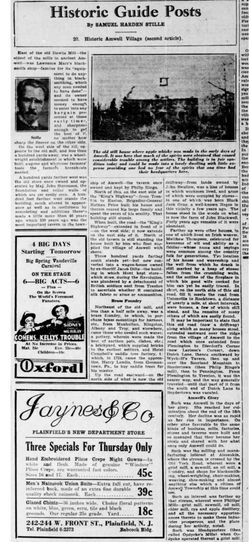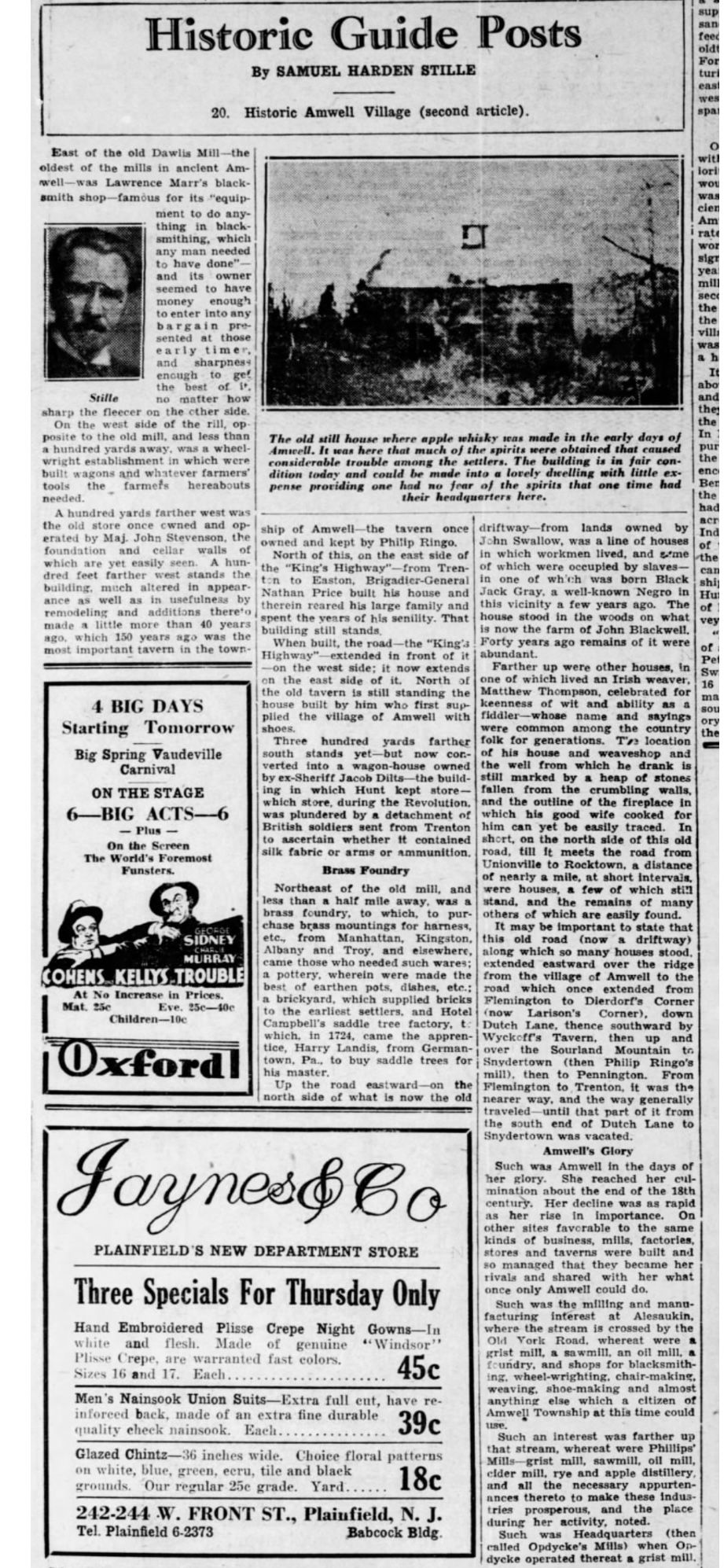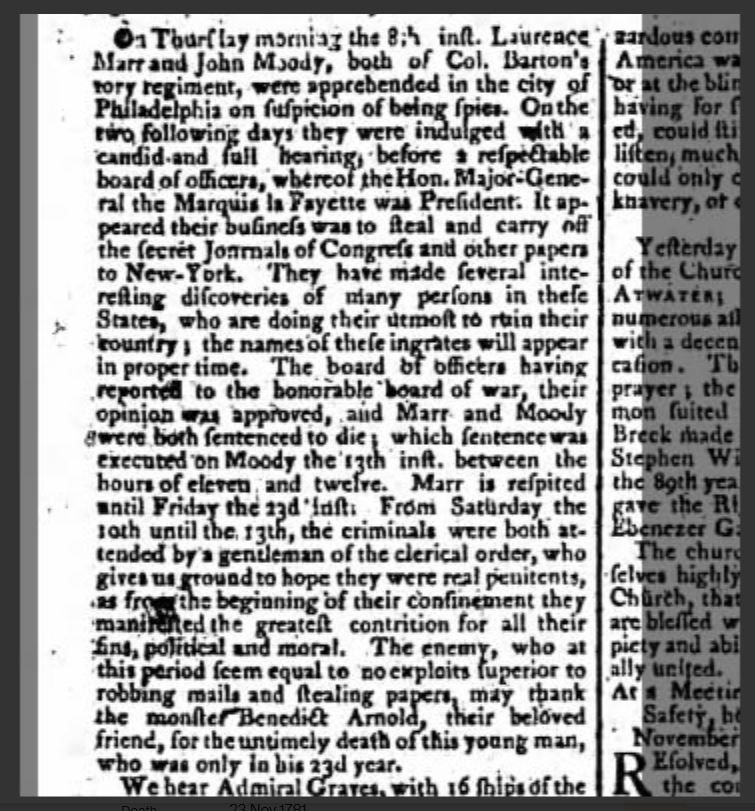It is said the original Lawrence Marr had five or six sons; that he and his eldest son were Loyalists during the war of the Revolution, and that his remaining sons, including David, supported the cause of independence.
Lawrence died before 1790.Research shows it was his youngest son Lawrence who was also a Loyalist and was with James Moody
His son Laurence is found in the 1790 Census of:
Name: Laurence Mare (Marr)
Township: Upper Mount Bethel
County: Northampton
State: Pennsylvania
Number of Free White Males Under 16: 2
Number of Free White Males 16 and Over: 2
Number of Free White Females: 3
Number of Household Members: 7
Biographical Sketches of Loyalists of the American Revolution, Vol. II
Mars Lawrence of Mt. Bethel , Pennsylvania, attainted of treason and property confiscated
~~~~
Date: March 06, 1782
Paper: Freeman's Journal, Pennsylvania
Forfeited Estates, Whereas the estates of the following named persons, that is to say , Lawrence Marr was named among hundreds of others.It goes on to say they have been convicted of treason against the state and all their real estate and personal properties will be forfeited and anyone holding any of the convicted's property or personal items must turn them over or be arrested.
~~~
Sketch xxv..The Longpoint Settlers:
The Earl of Marr ,The Marrs and Lemons of Norfolk.
EVERY young student of Scottish history has read of the two attempts made to re-establish the house of Stuart on the Scottish and English thrones--the first by the Chevalier de St. George, in 1715, and the second by his son, the gay and daring "Prince Charlie," in 1745. It will beremembered that it was the Earl of Mar who raised the standard of revolt when the first attempt was made; that 10,000 Highland clansmen joined his standard, and that the kilted revolters were
held in check by the Duke of Argyle until they were finally dispersed. It will also be remembered that the first Pretender escaped from the Highlands and returned to France, accompanied by the disappointed and crestfallen Earl of Mar.
Now, it is claimed on strong circumstantial evidence, that this old Scottish chieftain, who is described as Sir John Francis Mar, was a brother of Lawrence Marr, the father of David Marr, the old pioneer who settled on "Marr's Hill," in Woodhouse, at the beginning of the present century. It is said another brother or two besides Lawrence were implicated in this Jacobite revolt, and that Lawrence escaped into Ireland, and subsequently came to America and settled in
Northampton County, Penn., near the little town of Bethlehem, on the Delaware River. If this grand-ancestor of the Norfolk Marrs was really the Earl's brother, it is quite possible that a few corpuscles of royal Stuart blood course through their veins. A grandson of Robert II., the first Stuart who wore a crown, married the Countess of Mar, and secured the earldom. This Earl of Mar was the natural son of Sir Alexander Stuart. Later on, during the reign of James III., we find an Earl of Mar who was a brother of that king; and a century or two
Page 143
after we find another Earl of Mar entrusted with the guardianship of the youthful James VI., who also succeeded to the throne of England as James I.
It is said the Earl of Mar who led the insurrection in 1715 was a bachelor, and left a fine property in the vicinity of Paisley, County of Renfrew; and it is said Lawrence was the only brother who married and had children. It is upon this condition of things that the descendants of Lawrence Marr base their expectations of receiving a fortune. It has cost them a
Page 66
considerable sum already by way of investigations, and the chances are that, after incurring additional expenditure, the fortune will still "be acomin'," as is the case with the fortunes of so many of our old families. As before stated, there is good circumstantial evidence in favor of the claim. Lawrence is said to be the name of the missing heir, and Lawrence was the name of the grand-ancestor of the family in America, and, according to a family tradition, he was a refugee
from his native land on account of his participation in the Highland revolt. David Marr, the old Norfolk pioneer, had in his possession, it is said, a pair of massive silver knee-buckles and a pair of silver shoe-buckles which had belonged to his father; and if these silver trappings had been
worn by him in the Highlands, it would signify a social standing several degrees above the commonalty of the Highland peasantry, to say the least. No doubt there are numerous unclaimed fortunes in Europe awaiting American claimants, but the difficulty is in furnishing the required proofs. With the stringent registration laws now in force, future claimants will have less difficulty in tracing back their ancestry.
Lawrence Marr died in Pennsylvania, leaving several sons and daughters. One of these sons, David, and one daughter, Mary, with her husband, Jacob Lemon, came to Long Point. It is said that Thomas, another son, started for Canada, but died on the way; and that Richard Marr, late of Woodhouse, was a twig of this branch.
David Marr had thirteen children, twelve of whom grew up.
Marr Name:
Scottish: habitational name from Mar in Aberdeenshire, the etymology of which is uncertain, possibly Old Norse marr, a rare word generally denoting the sea, but perhaps also a marsh or fen, as reflected in modern dialect forms.
English: habitational name from Marr in West Yorkshire, whose name is likewise of uncertain origin; possibly the same as 1.
German: from the Germanic personal name Marro.
~ ~ ~
I am a direct descendant of Mary Marr & Jacob Joseph Lemon.
I have a copy of the Mutrie research for the Marr family. According to their research Lawrence was born in 1689 and died in 1779.
James R. Lemon
Contributor: James Lemon (46987614)
It is said the original Lawrence Marr had five or six sons; that he and his eldest son were Loyalists during the war of the Revolution, and that his remaining sons, including David, supported the cause of independence.
Lawrence died before 1790.Research shows it was his youngest son Lawrence who was also a Loyalist and was with James Moody
His son Laurence is found in the 1790 Census of:
Name: Laurence Mare (Marr)
Township: Upper Mount Bethel
County: Northampton
State: Pennsylvania
Number of Free White Males Under 16: 2
Number of Free White Males 16 and Over: 2
Number of Free White Females: 3
Number of Household Members: 7
Biographical Sketches of Loyalists of the American Revolution, Vol. II
Mars Lawrence of Mt. Bethel , Pennsylvania, attainted of treason and property confiscated
~~~~
Date: March 06, 1782
Paper: Freeman's Journal, Pennsylvania
Forfeited Estates, Whereas the estates of the following named persons, that is to say , Lawrence Marr was named among hundreds of others.It goes on to say they have been convicted of treason against the state and all their real estate and personal properties will be forfeited and anyone holding any of the convicted's property or personal items must turn them over or be arrested.
~~~
Sketch xxv..The Longpoint Settlers:
The Earl of Marr ,The Marrs and Lemons of Norfolk.
EVERY young student of Scottish history has read of the two attempts made to re-establish the house of Stuart on the Scottish and English thrones--the first by the Chevalier de St. George, in 1715, and the second by his son, the gay and daring "Prince Charlie," in 1745. It will beremembered that it was the Earl of Mar who raised the standard of revolt when the first attempt was made; that 10,000 Highland clansmen joined his standard, and that the kilted revolters were
held in check by the Duke of Argyle until they were finally dispersed. It will also be remembered that the first Pretender escaped from the Highlands and returned to France, accompanied by the disappointed and crestfallen Earl of Mar.
Now, it is claimed on strong circumstantial evidence, that this old Scottish chieftain, who is described as Sir John Francis Mar, was a brother of Lawrence Marr, the father of David Marr, the old pioneer who settled on "Marr's Hill," in Woodhouse, at the beginning of the present century. It is said another brother or two besides Lawrence were implicated in this Jacobite revolt, and that Lawrence escaped into Ireland, and subsequently came to America and settled in
Northampton County, Penn., near the little town of Bethlehem, on the Delaware River. If this grand-ancestor of the Norfolk Marrs was really the Earl's brother, it is quite possible that a few corpuscles of royal Stuart blood course through their veins. A grandson of Robert II., the first Stuart who wore a crown, married the Countess of Mar, and secured the earldom. This Earl of Mar was the natural son of Sir Alexander Stuart. Later on, during the reign of James III., we find an Earl of Mar who was a brother of that king; and a century or two
Page 143
after we find another Earl of Mar entrusted with the guardianship of the youthful James VI., who also succeeded to the throne of England as James I.
It is said the Earl of Mar who led the insurrection in 1715 was a bachelor, and left a fine property in the vicinity of Paisley, County of Renfrew; and it is said Lawrence was the only brother who married and had children. It is upon this condition of things that the descendants of Lawrence Marr base their expectations of receiving a fortune. It has cost them a
Page 66
considerable sum already by way of investigations, and the chances are that, after incurring additional expenditure, the fortune will still "be acomin'," as is the case with the fortunes of so many of our old families. As before stated, there is good circumstantial evidence in favor of the claim. Lawrence is said to be the name of the missing heir, and Lawrence was the name of the grand-ancestor of the family in America, and, according to a family tradition, he was a refugee
from his native land on account of his participation in the Highland revolt. David Marr, the old Norfolk pioneer, had in his possession, it is said, a pair of massive silver knee-buckles and a pair of silver shoe-buckles which had belonged to his father; and if these silver trappings had been
worn by him in the Highlands, it would signify a social standing several degrees above the commonalty of the Highland peasantry, to say the least. No doubt there are numerous unclaimed fortunes in Europe awaiting American claimants, but the difficulty is in furnishing the required proofs. With the stringent registration laws now in force, future claimants will have less difficulty in tracing back their ancestry.
Lawrence Marr died in Pennsylvania, leaving several sons and daughters. One of these sons, David, and one daughter, Mary, with her husband, Jacob Lemon, came to Long Point. It is said that Thomas, another son, started for Canada, but died on the way; and that Richard Marr, late of Woodhouse, was a twig of this branch.
David Marr had thirteen children, twelve of whom grew up.
Marr Name:
Scottish: habitational name from Mar in Aberdeenshire, the etymology of which is uncertain, possibly Old Norse marr, a rare word generally denoting the sea, but perhaps also a marsh or fen, as reflected in modern dialect forms.
English: habitational name from Marr in West Yorkshire, whose name is likewise of uncertain origin; possibly the same as 1.
German: from the Germanic personal name Marro.
~ ~ ~
I am a direct descendant of Mary Marr & Jacob Joseph Lemon.
I have a copy of the Mutrie research for the Marr family. According to their research Lawrence was born in 1689 and died in 1779.
James R. Lemon
Contributor: James Lemon (46987614)
Family Members
Advertisement
Explore more
Sponsored by Ancestry
Advertisement







